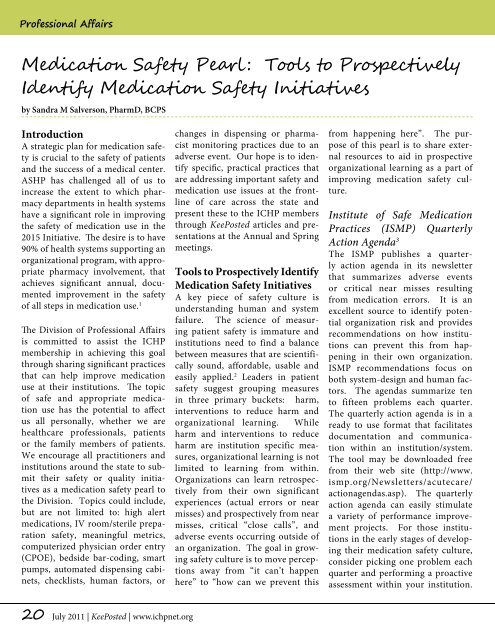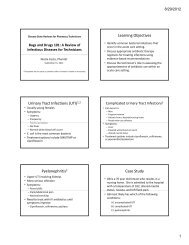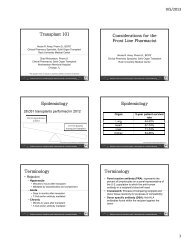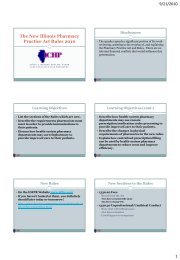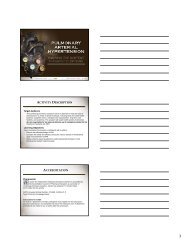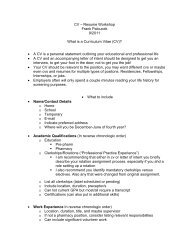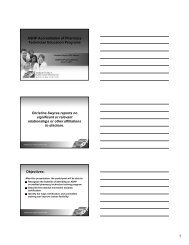KeePosted - ICHP
KeePosted - ICHP
KeePosted - ICHP
Create successful ePaper yourself
Turn your PDF publications into a flip-book with our unique Google optimized e-Paper software.
Professional Affairs<br />
Medication Safety Pearl : Tools to Prospectively<br />
Identify Medication Safety Initiatives<br />
by Sandra M Salverson, PharmD, BCPS<br />
Introduction<br />
A strategic plan for medication safety<br />
is crucial to the safety of patients<br />
and the success of a medical center.<br />
ASHP has challenged all of us to<br />
increase the extent to which pharmacy<br />
departments in health systems<br />
have a significant role in improving<br />
the safety of medication use in the<br />
2015 Initiative. The desire is to have<br />
90% of health systems supporting an<br />
organizational program, with appropriate<br />
pharmacy involvement, that<br />
achieves significant annual, documented<br />
improvement in the safety<br />
of all steps in medication use. 1<br />
The Division of Professional Affairs<br />
is committed to assist the <strong>ICHP</strong><br />
membership in achieving this goal<br />
through sharing significant practices<br />
that can help improve medication<br />
use at their institutions. The topic<br />
of safe and appropriate medication<br />
use has the potential to affect<br />
us all personally, whether we are<br />
healthcare professionals, patients<br />
or the family members of patients.<br />
We encourage all practitioners and<br />
institutions around the state to submit<br />
their safety or quality initiatives<br />
as a medication safety pearl to<br />
the Division. Topics could include,<br />
but are not limited to: high alert<br />
medications, IV room/sterile preparation<br />
safety, meaningful metrics,<br />
computerized physician order entry<br />
(CPOE), bedside bar-coding, smart<br />
pumps, automated dispensing cabinets,<br />
checklists, human factors, or<br />
changes in dispensing or pharmacist<br />
monitoring practices due to an<br />
adverse event. Our hope is to identify<br />
specific, practical practices that<br />
are addressing important safety and<br />
medication use issues at the frontline<br />
of care across the state and<br />
present these to the <strong>ICHP</strong> members<br />
through <strong>KeePosted</strong> articles and presentations<br />
at the Annual and Spring<br />
meetings.<br />
Tools to Prospectively Identify<br />
Medication Safety Initiatives<br />
A key piece of safety culture is<br />
understanding human and system<br />
failure. The science of measuring<br />
patient safety is immature and<br />
institutions need to find a balance<br />
between measures that are scientifically<br />
sound, affordable, usable and<br />
easily applied. 2 Leaders in patient<br />
safety suggest grouping measures<br />
in three primary buckets: harm,<br />
interventions to reduce harm and<br />
organizational learning. While<br />
harm and interventions to reduce<br />
harm are institution specific measures,<br />
organizational learning is not<br />
limited to learning from within.<br />
Organizations can learn retrospectively<br />
from their own significant<br />
experiences (actual errors or near<br />
misses) and prospectively from near<br />
misses, critical “close calls”, and<br />
adverse events occurring outside of<br />
an organization. The goal in growing<br />
safety culture is to move perceptions<br />
away from “it can’t happen<br />
here” to “how can we prevent this<br />
from happening here”. The purpose<br />
of this pearl is to share external<br />
resources to aid in prospective<br />
organizational learning as a part of<br />
improving medication safety culture.<br />
Institute of Safe Medication<br />
Practices (ISMP) Quarterly<br />
Action Agenda 3<br />
The ISMP publishes a quarterly<br />
action agenda in its newsletter<br />
that summarizes adverse events<br />
or critical near misses resulting<br />
from medication errors. It is an<br />
excellent source to identify potential<br />
organization risk and provides<br />
recommendations on how institutions<br />
can prevent this from happening<br />
in their own organization.<br />
ISMP recommendations focus on<br />
both system-design and human factors.<br />
The agendas summarize ten<br />
to fifteen problems each quarter.<br />
The quarterly action agenda is in a<br />
ready to use format that facilitates<br />
documentation and communication<br />
within an institution/system.<br />
The tool may be downloaded free<br />
from their web site (http://www.<br />
ismp.org/Newsletters/acutecare/<br />
actionagendas.asp). The quarterly<br />
action agenda can easily stimulate<br />
a variety of performance improvement<br />
projects. For those institutions<br />
in the early stages of developing<br />
their medication safety culture,<br />
consider picking one problem each<br />
quarter and performing a proactive<br />
assessment within your institution.<br />
20 July 2011 | <strong>KeePosted</strong> | www.ichpnet.org


